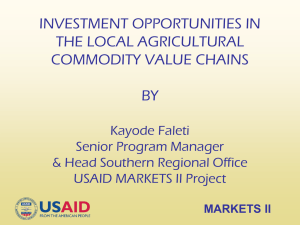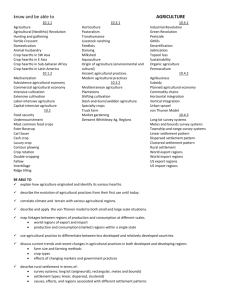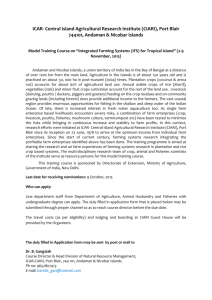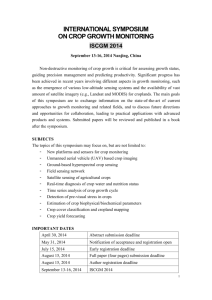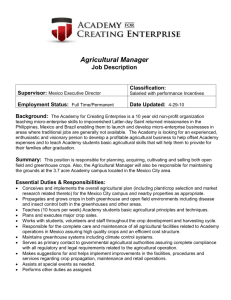repositioning the college of agricultural sciences for global relevance
advertisement
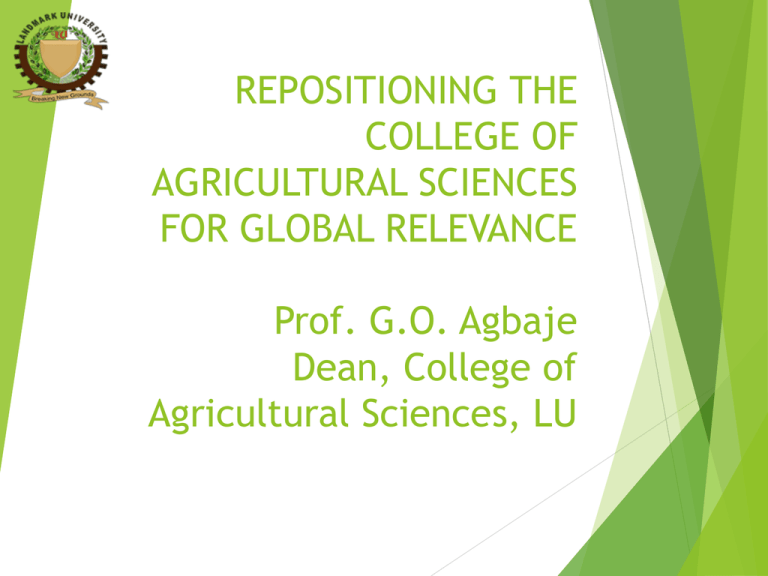
REPOSITIONING THE COLLEGE OF AGRICULTURAL SCIENCES FOR GLOBAL RELEVANCE Prof. G.O. Agbaje Dean, College of Agricultural Sciences, LU WHERE ARE WE? Facilities and equipment on ground Green house tomato production in Landmark University Tomatoes under drip irrigation system 2000 day-old chicks for broiler production Laying birds at Teaching and Research Farm The fishery unit under construction at Teaching and Research Farm Table size production unit Fingerlings production tank Animal pens under construction Piggery unit Sheep & goat units Ploughed paddock Herds of Cattle in T & R Farm Sophisticated Laboratory Equipment at College of Agricultural Sciences Lab Amino acid analyzer Fiber analyzer Staff Capacity Six Professors: Two from Department of Crop & Soil Sciences ; Two from Department of Animal Sciences; Two from Department of Agric Economics & Extension . Three Associate Professors: Two from of Department Agric Economics & Extension One from of Department of Crop & Soil Sciences Twelve senior lectures, four lecturer I and twelve lecturer II Three laboratory technologist Six Administrative officers Total of twenty-five staff at the Teaching & Research Farm Measures to efficiently utilize and maintain our infrastructures Appointment of Directors to anchor different units; Broiler unit, Layers unit, Feedmill, Tractor and crop cultivation, Pasture development and management Receipt now issued for all laboratory analysis carried out in the lab Only laboratory technologists are now permitted to handle sensitive equipment All payments from poultry sales are paid into a sundry account of the university a separate account is advocated for all revenues from the college Global Relevance Defined as: Ability or capacity to compete or contribute to the “global knowledge economy” by using technology to address most pressing problems Ability to achieve quality standard that transcends national borders and to transform to a world-class research and higher education institution Ability to develop knowledge and train graduates that can compete in global knowledge economy. Most of the graduates should be employable by international organizations Where do we contribute to global knowledge economy? - Poverty reduction - narrowing income disparities through agricultural enterprise development -providing food security studies and solutions - reduction in environmental hazards and pollution Collaboration to develop simple machines Characteristics of a worldclass university To be globally relevant we must strive to be a world-class university and the focus is research, although teaching and other services are not neglected World-class ratings following activities: are achieved by the High concentration of talents from all over the world Abundant resources to offer environment and conduct research Favourable govenance that enable resources to be managed and not encumbered by bureaucracy rich learning Methodology of the three leading international ranking The Academic Ranking of World Universities(ARWU) prepared by Shanghai Jiao Tong University Indicators are: Quality of education: alumni of an institution winning Nobel Prizes and Field medals(10%) Quality of faculty:(a) staff of an institution winning Nobel Prizes and Field Medals(20%) and (b) highly cited researchers in 21 broad subject categories(20%) Research output: (a) paper publish in nature and science (20%); and (b) paper index in Science Citation Index-expanded and Social Science Citation Index (20%) Per capital performance : per capital academic performance of an institution (10%)(defined as a weighted score of the other five indicators divided by the number of full time equivalent academic staff members) Times Higher Education (THE) : the 13 indicators use for scoring are: Industry income-innovation : institution's research income from industry scaled against the number of academic staff members (2.5% of final ranking) Teaching –the learning environment (5%): result of a repertory survey on teaching(15%); staff-to-student ration (4.5%); ration of PhD to bachelor’s degree awarded by each institution (2.25%); number of PhDs awarded by an institution, scaled against its size and institutional income scaled against academic staff numbers Citation-research influence :number of times a university’s published work is cited by academics (2.25%) Research-volume, income and reputation : results of a reputational survey (19.5%), university research income (5.25%), number of papers published in academic journals indexed by Thomson Reuters per staff member (4.5%); public research income against university total research income (0.75%) International mix- staff and students : ration of international to domestic staff members (3%) ; and ratio of international to domestic students (2%) Classical example of breakthrough into top ranking Universities The number of Chinese Universities in Academic Ranking of World Universities(SJTU,2008) in the 300 top universities increased from 0 in 2000 to 6 in 2008, the number in top 500 increased from 4 to 18 in the same period. Reasons for the increase: - Capacity development of faculty, administrative and technical staff members, - encourage interdisciplinary research - promote international cooperation, - increased research funding - reward staff for publishing in Science indexed journal and Nature and Science with as much as $1,400 per publication - attract best students all over the world by giving out scholarship - set up performance evaluation in each department -enlist reputable international Professors as visiting scholars -encourage attendance of international conferences What do we do to be globally relevant? Develop expertise in climate change management which is a global phenomenon affecting agricultural productivity Employ the use of Molecular biology and biotechnology to study genes that influences yield and quality traits in plants and animal. Train our technologists on the use and handling of equipment in the laboratories Undertake research in the areas of nutrient use efficiency, organic agriculture, biogas generation from agricultural waste, biofuel, crop management etc Conduct research in efficiency of feed and feed utilization in various livestock for egg, meat and goat milk production Encourage international research collaboration, seek external research funding and publish only in Thomson Reuters indexed journals Perfect and expand urban cultivation of crops using greenhouses Encourage the hosting and organization of workshops, conferences and training in agriculture Performance evaluation standard will be set for each department Recruit best students all over the world for undergraduate and postgraduate training in the college. QUALITY NOT QUANTITY. Students are taught using latest research findings and exposed to animals and crops entrepreneurial management during the Farm Practical Year Float new courses to increase student enrolment in the college( Crop Science and climatology; Agric Communication and Media studies, Agricultural Business and management) . Where we are going


